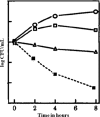Combination therapy for treatment of infections with gram-negative bacteria
- PMID: 22763634
- PMCID: PMC3416487
- DOI: 10.1128/CMR.05041-11
Combination therapy for treatment of infections with gram-negative bacteria
Abstract
Combination antibiotic therapy for invasive infections with Gram-negative bacteria is employed in many health care facilities, especially for certain subgroups of patients, including those with neutropenia, those with infections caused by Pseudomonas aeruginosa, those with ventilator-associated pneumonia, and the severely ill. An argument can be made for empiric combination therapy, as we are witnessing a rise in infections caused by multidrug-resistant Gram-negative organisms. The wisdom of continued combination therapy after an organism is isolated and antimicrobial susceptibility data are known, however, is more controversial. The available evidence suggests that the greatest benefit of combination antibiotic therapy stems from the increased likelihood of choosing an effective agent during empiric therapy, rather than exploitation of in vitro synergy or the prevention of resistance during definitive treatment. In this review, we summarize the available data comparing monotherapy versus combination antimicrobial therapy for the treatment of infections with Gram-negative bacteria.
Figures





References
-
- Aaron SD, Ferris W, Henry DA, Speert DP, Macdonald NE. 2000. Multiple combination bactericidal antibiotic testing for patients with cystic fibrosis infected with Burkholderia cepacia. Am. J. Respir. Crit. Care Med. 161:1206–1212 - PubMed
-
- Aaron SD, et al. 2005. Combination antibiotic susceptibility testing to treat exacerbations of cystic fibrosis associated with multiresistant bacteria: a randomised, double-blind, controlled clinical trial. Lancet 366:463–471 - PubMed
-
- Aarts MA, Hancock JN, Heyland D, McLeod RS, Marshall JC. 2008. Empiric antibiotic therapy for suspected ventilator-associated pneumonia: a systematic review and meta-analysis of randomized trials. Crit. Care Med. 36:108–117 - PubMed
Publication types
MeSH terms
Substances
LinkOut - more resources
Full Text Sources
Other Literature Sources
Medical

